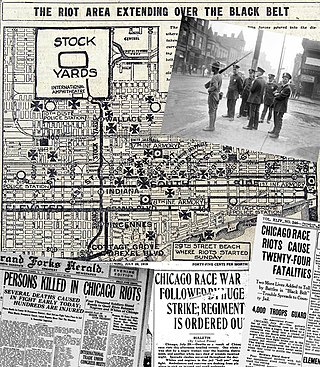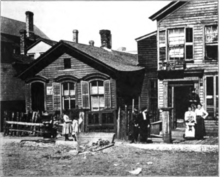
A ghetto is a part of a city in which members of a minority group are concentrated, especially as a result of political, social, legal, religious, environmental or economic pressure. Ghettos are often known for being more impoverished than other areas of the city. Versions of such restricted areas have been found across the world, each with their own names, classifications, and groupings of people.

Five Points was a 19th-century neighborhood in Lower Manhattan, New York City. The neighborhood, partly built on low-lying land which had filled in the freshwater lake known as the Collect Pond, was generally defined as being bound by Centre Street to the west, the Bowery to the east, Canal Street to the north, and Park Row to the south. The Five Points gained international notoriety as a densely populated, disease-ridden, crime-infested slum which existed for over 70 years.

The Great Migration, sometimes known as the Great Northward Migration or the Black Migration, was the movement of six million African Americans out of the rural Southern United States to the urban Northeast, Midwest, and West between 1910 and 1970. It was substantially caused by poor economic and social conditions due to prevalent racial segregation and discrimination in the Southern states where Jim Crow laws were upheld. In particular, continued lynchings motivated a portion of the migrants, as African Americans searched for social reprieve. The historic change brought by the migration was amplified because the migrants, for the most part, moved to the then-largest cities in the United States at a time when those cities had a central cultural, social, political, and economic influence over the United States; there, African-Americans established culturally influential communities of their own. According to Isabel Wilkerson, despite the loss of leaving their homes in the South, and the barriers faced by the migrants in their new homes, the migration was an act of individual and collective agency, which changed the course of American history, a "declaration of independence" written by their actions.
Geographical segregation exists whenever the proportions of population rates of two or more populations are not homogeneous throughout a defined space. Populations can be considered any plant or animal species, human genders, followers of a certain religion, people of different nationalities, ethnic groups, etc.

The demographics of Chicago show that it is a large, and ethnically and culturally diverse metropolis. It is the third largest city and metropolitan area in the United States by population. Chicago was home to over 2.7 million people in 2020, accounting for over 25% of the population in the Chicago metropolitan area, home to approximately 9.6 million.

The history of African Americans in Chicago or Black Chicagoans dates back to Jean Baptiste Point du Sable's trading activities in the 1780s. Du Sable, the city's founder, was Haitian of African and French descent. Fugitive slaves and freedmen established the city's first black community in the 1840s. By the late 19th century, the first black person had been elected to office.
The Chicago Freedom Movement, also known as the Chicago open housing movement, was led by Martin Luther King Jr., James Bevel and Al Raby. It was supported by the Chicago-based Coordinating Council of Community Organizations (CCCO) and the Southern Christian Leadership Conference (SCLC). The movement included a large rally, marches, and demands to the City of Chicago. These specific demands covered a wide range of areas besides open housing, and included quality education, transportation and job access, income and employment, health, wealth generation, crime and the criminal justice system, community development, tenants rights, and quality of life. Operation Breadbasket, in part led by Jesse Jackson, sought to harness African-American consumer power. The Chicago Freedom Movement was the most ambitious civil rights campaign in the North of the United States, lasted from mid-1965 to August 1966, and is largely credited with inspiring the 1968 Fair Housing Act.
The 1943Detroit race riot took place in Detroit, Michigan, from the evening of June 20 through to the early morning of June 22. It occurred in a period of dramatic population increase and social tensions associated with the military buildup of U.S. participation in World War II, as Detroit's automotive industry was converted to the war effort. Existing social tensions and housing shortages were exacerbated by racist feelings about the arrival of nearly 400,000 migrants, both African-American and White Southerners, from the Southeastern United States between 1941 and 1943. The migrants competed for space and jobs against the city's residents as well as against European immigrants and their descendants. The riot escalated after a false rumor spread that a mob of whites had thrown a black mother and her baby into the Detroit River. Blacks looted and destroyed white property as retaliation. Whites overran Woodward to Veron where they proceeded to violently attack black community members and tip over 20 cars that belonged to black families.

The Chicago race riot of 1919 was a violent racial conflict between white Americans and black Americans that began on the South Side of Chicago, Illinois, on July 27 and ended on August 3, 1919. During the riot, 38 people died. Over the week, injuries attributed to the episodic confrontations stood at 537, two-thirds black and one-third white; and between 1,000 and 2,000 residents, most of them black, lost their homes. Due to its sustained violence and widespread economic impact, it is considered the worst of the scores of riots and civil disturbances across the United States during the "Red Summer" of 1919, so named because of its racial and labor violence. It was also one of the worst riots in the history of Illinois.

In the context of the 20th-century history of the United States, the Second Great Migration was the migration of more than 5 million African Americans from the South to the Northeast, Midwest and West. It began in 1940, through World War II, and lasted until 1970. It was much larger and of a different character than the first Great Migration (1916–1940), where the migrants were mainly rural farmers from the South and only came to the Northeast and Midwest.
The Near North Side of Omaha, Nebraska is the neighborhood immediately north of downtown. It forms the nucleus of the city's historic African-American community, and its name is often synonymous with the entire North Omaha area. Originally established immediately after Omaha was founded in 1854, the Near North Side was once confined to the area around Dodge Street and North 7th Street. Eventually, it gravitated west and north, and today it is bordered by Cuming Street on the south, 30th on the west, 16th on the east, and Locust Street to the north. Countless momentous events in Omaha's African American community happened in the Near North Side, including the 1865 establishment of the first Black church in Omaha, St. John's AME; the 1892 election of the first African American state legislator, Dr. Matthew Ricketts; the 1897 hiring of the first Black teacher in Omaha, Ms. Lucy Gamble, the 1910 Jack Johnson riots, the Omaha race riot of 1919 that almost demolished the neighborhood and many other events.
Ethnic succession theory is a theory in sociology stating that ethnic and racial groups entering a new area may settle in older neighborhoods or urban areas until achieving economic parity with certain economic classes. The concept of succession is well established in "both ecological and economic models of urban residential change." As the newer group becomes economically successful, it moves to a better residential area. With continued immigration, a new ethnic group will settle in the older neighborhood in a similar starting situation. This pattern will continue, creating a succession of groups moving through the neighborhood over time. Ethnic succession has taken place in most major United States cities, but is most well known in New York City, where this process has been observed since the 19th century.
African-American neighborhoods or black neighborhoods are types of ethnic enclaves found in many cities in the United States. Generally, an African American neighborhood is one where the majority of the people who live there are African American. Some of the earliest African-American neighborhoods were in New Orleans, Mobile, Atlanta, and other cities throughout the American South, as well as in New York City. In 1830, there were 14,000 "Free negroes" living in New York City.

Columbus Square is a neighborhood of St. Louis, Missouri. It is bounded by Cass Avenue to the north, I-70 to the east, Tucker & North 13th Streets to the west, and Cole Street to the south.
Residential segregation is the physical separation of two or more groups into different neighborhoods—a form of segregation that "sorts population groups into various neighborhood contexts and shapes the living environment at the neighborhood level". While it has traditionally been associated with racial segregation, it generally refers to the separation of populations based on some criteria.
In the United States, housing segregation is the practice of denying African Americans and other minority groups equal access to housing through the process of misinformation, denial of realty and financing services, and racial steering. Housing policy in the United States has influenced housing segregation trends throughout history. Key legislation include the National Housing Act of 1934, the G.I. Bill, and the Fair Housing Act. Factors such as socioeconomic status, spatial assimilation, and immigration contribute to perpetuating housing segregation. The effects of housing segregation include relocation, unequal living standards, and poverty. However, there have been initiatives to combat housing segregation, such as the Section 8 housing program.
Various ethnic groups in Omaha, Nebraska have lived in the city since its organization by Anglo-Americans in 1854. Native Americans of various nations lived in the Omaha territory for centuries before European arrival, and some stayed in the area. The city was founded by white Anglo-Saxon Protestants from neighboring Council Bluffs, Iowa. However, since the first settlement, substantial immigration from all of Europe, migration by African Americans from the Deep South and various ethnic groups from the Eastern United States, and new waves of more recent immigrants from Mexico and Africa have added layers of complexity to the workforce, culture, religious and social fabric of the city.
The Fernwood Park Race Riot was a race massacre instigated by white residents against African American residents who inhabited the Chicago Housing Authority (CHA) veterans' housing project in the Fernwood Park neighborhood in Chicago. Area residents viewed this as one of several attempts by the CHA to initiate racial integration into white communities. The riot took place between 98th and 111th streets and lasted for three days, from the day veterans and their families moved into the project, August 13th, 1947 to August 16th, 1947. The Chicago Police Department did little to stop the rioting, as was the case a year before at the Airport Homes race riots. It was one of the worst race riots in Chicago history.

Black Detroiters are black or African American residents of Detroit. According to the U.S. Census Bureau, Black or African Americans living in Detroit accounted for 79.1% of the total population, or approximately 532,425 people as of 2017 estimates. According to the 2000 U.S. Census, of all U.S. cities with 100,000 or more people, Detroit had the second-highest percentage of Black people.

Albina is a collection of neighborhoods located in the North and Northeast sections of Portland, Oregon, United States. For most of the 20th century it was home to the majority of the city’s African American population. The area derives its name from Albina, Oregon, a historical American city that was consolidated into Portland in 1891. Albina includes the modern Portland neighborhoods of Eliot, Boise, Humboldt, Overlook, and Piedmont.











